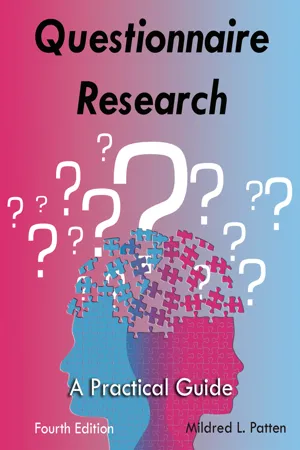
- 154 pages
- English
- ePUB (mobile friendly)
- Available on iOS & Android
About this book
• Provides step-by-step guidance for students who will be conducting their first surveys to collect factual information, measure attitudes, and evaluate products, services, and programs using questionnaires.
• Each chapter is structured around easy-to-follow guidelines.
• Numerous examples illustrate the guidelines. The examples are on timely topics of interest to students.
• This short book is an ideal supplement for guiding students through a class project. At the end of Chapter 1, they write the objectives for their questionnaires. They then follow the guidelines in subsequent chapters to complete their project.
• Exercises at the end of each chapter allow students to practice their newly acquired skills.
• Students learn that using questionnaires in research is both an art and a science—with principles that need to be followed for efficient, effective data collection.
• Thoroughly field-tested for student interest and comprehension, this book is sure to please both you and your students.
• We've had highly positive feedback from the numerous professors who have adopted this book to guide students in conducting term projects.
Frequently asked questions
- Essential is ideal for learners and professionals who enjoy exploring a wide range of subjects. Access the Essential Library with 800,000+ trusted titles and best-sellers across business, personal growth, and the humanities. Includes unlimited reading time and Standard Read Aloud voice.
- Complete: Perfect for advanced learners and researchers needing full, unrestricted access. Unlock 1.4M+ books across hundreds of subjects, including academic and specialized titles. The Complete Plan also includes advanced features like Premium Read Aloud and Research Assistant.
Please note we cannot support devices running on iOS 13 and Android 7 or earlier. Learn more about using the app.
Information
Chapter 1
Planning Questionnaire Research
Guideline 1.1 Consider the advantages and disadvantages of using questionnaires.
- Structured telephone interviews in which all respondents are asked the same questions—usually short-answer or multiple-choice questions.
- In-depth, semistructured personal interviews in which interviewers have some questions they ask all respondents but may also follow up with additional questions constructed on the spot to take advantage of leads, obtain additional details, and so on.
Advantages of Using Questionnaires in Research
1.1.1 Questionnaires provide an efficient way to collect data.
1.1.2 Questionnaires are useful for collecting information on sensitive matters.
1.1.3 Questionnaire research is economical.
Disadvantages of Using Questionnaires in Research
1.1.4 The response rate to questionnaires is often low.
1.1.5 Questionnaires may provide only a snapshot.
1.1.6 Questionnaires elicit socially desirable responses.
Guideline 1.2 Prepare written objectives for the research.
Table of contents
- Cover
- Title
- Copyright
- Contents
- Introduction
- 1. Planning Questionnaire Research
- 2. Writing Items to Collect Factual Information
- 3. Writing Items to Collect Demographic Information
- 4. Writing Items to Measure Attitudes
- 5. Writing Items to Evaluate Products, Services, and Programs
- 6. Conducting Item Tryouts and an Item Analysis
- 7. Preparing a Questionnaire for Administration
- 8. Selecting a Sample of Respondents
- 9. Preparing Statistical Tables and Figures
- 10. Describing Averages and Variability
- 11. Describing Relationships
- 12. Estimating Margins of Error
- 13. Writing Reports of Questionnaire Research
- Appendix A Questions on Race Used in the 2010 Census
- Appendix B Sample Cover Letter for a Questionnaire
- Appendix C Sample Informed Consent Form
- Appendix D Sample Follow-up Postcard
- Appendix E Table of Random Numbers
- Appendix F Introduction to Statistical Significance
- Appendix G Other Computational Procedures
- Appendix H Sample Questionnaire: Attitudes Toward Statistics Questionnaire
- Appendix I Sample Questionnaire: Campus Bookstore Evaluation
- Appendix J Checklist of Guidelines